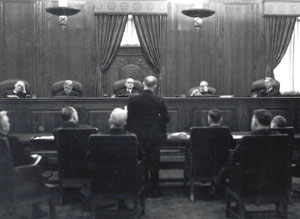
Tennessee Supreme Court
Tennessee’s first constitution did not create a state supreme court. The Constitution of 1796 provided only for “such superior and inferior courts” as the legislature should create, with the judges to be elected by the general assembly to serve “during their good behavior.” In 1809 the legislature finally created the Supreme Court of Errors and Appeals composed of two judges; on appeal cases, a circuit judge who had not participated in the trial in a lower court joined the two justices. Moreover, the jurisdiction of this supreme court was not exclusively appellate. Until 1834 the court exercised original jurisdiction over the trial of equity cases, many of which involved titles to land–a very important field of the law in the early days of the state. The earlier lack of constitutional standing subjected the tenure of the judges to legislative whim, but the court ruled on the constitutionality of many state statutes.
Tennessee’s second constitution, adopted in 1834, made provision for a supreme court composed of three judges. The constitution granted the court appellate jurisdiction only and fixed the tenure of judges at twelve years. The constitution required one judge from each grand division of the state and stipulated that judges had to be at least thirty-five years old.
In 1870 Tennessee adopted its third and last constitution. It provided for a five-judge supreme court and required that not more than two judges could reside in any one of the three grand divisions. The court is required to hold sessions in Knoxville, Nashville, and Jackson. Judges are popularly elected for terms of eight years. Judges must be residents of the state for five years and at least thirty-five years of age. The state legislature fixes the compensation for judges, and it cannot be increased or decreased during their term of office. According to a 1994 act, when an incumbent supreme court judge seeks election or reelection for a full eight-year term, the judge shall be retained in office, if, at the next regular August election, he or she receives a favorable majority vote. In August 1996 Supreme Court Justice Penny White, who had been appointed by Governor Ned R. McWherter to fill an unexpired term, was turned out of office by the voters.
Other constitutional provisions require the judges of the Tennessee Supreme Court to designate one of their number as chief justice. In recent years, the office of chief justice has been rotated among the judges; in earlier courts, one justice held the office throughout his tenure. Concurrence of three of the judges shall, in every case, be necessary to reach a decision. In the pre-Civil War history of the court, dissenting opinions were more frequent than has been true of recent rulings. Unanimity or dissent probably reflects the state political situation and the particular makeup of the court.
According to a unique constitutional provision, the judges of the supreme court appoint the attorney general and reporter of the state for a term of eight years. The people of forty-three states elect the attorney general; in five, the governor appoints the chief lawyer of the people; and in Maine, the legislature elects the top lawyer by secret ballot. Challengers to Tennessee’s controversial method of selection argue that there is a built-in conflict of interest when the state’s chief lawyer is chosen by the very body before whom he or she must argue cases. So far, these challenges have been unsuccessful.
Two Tennessee Supreme Court justices, John Catron and Horace Lurton, received subsequent appointments to the Supreme Court of the United States. Of the many judges who have served on the Tennessee Supreme Court, Grafton Green (1910-47) had the longest tenure. He served as chief justice from 1923 until his death in 1947 and is widely recognized for his judicial skill and knowledge of the law.
Suggested Reading
Samuel C. Williams, Phases of the History of the Tennessee Supreme Court (1944)



